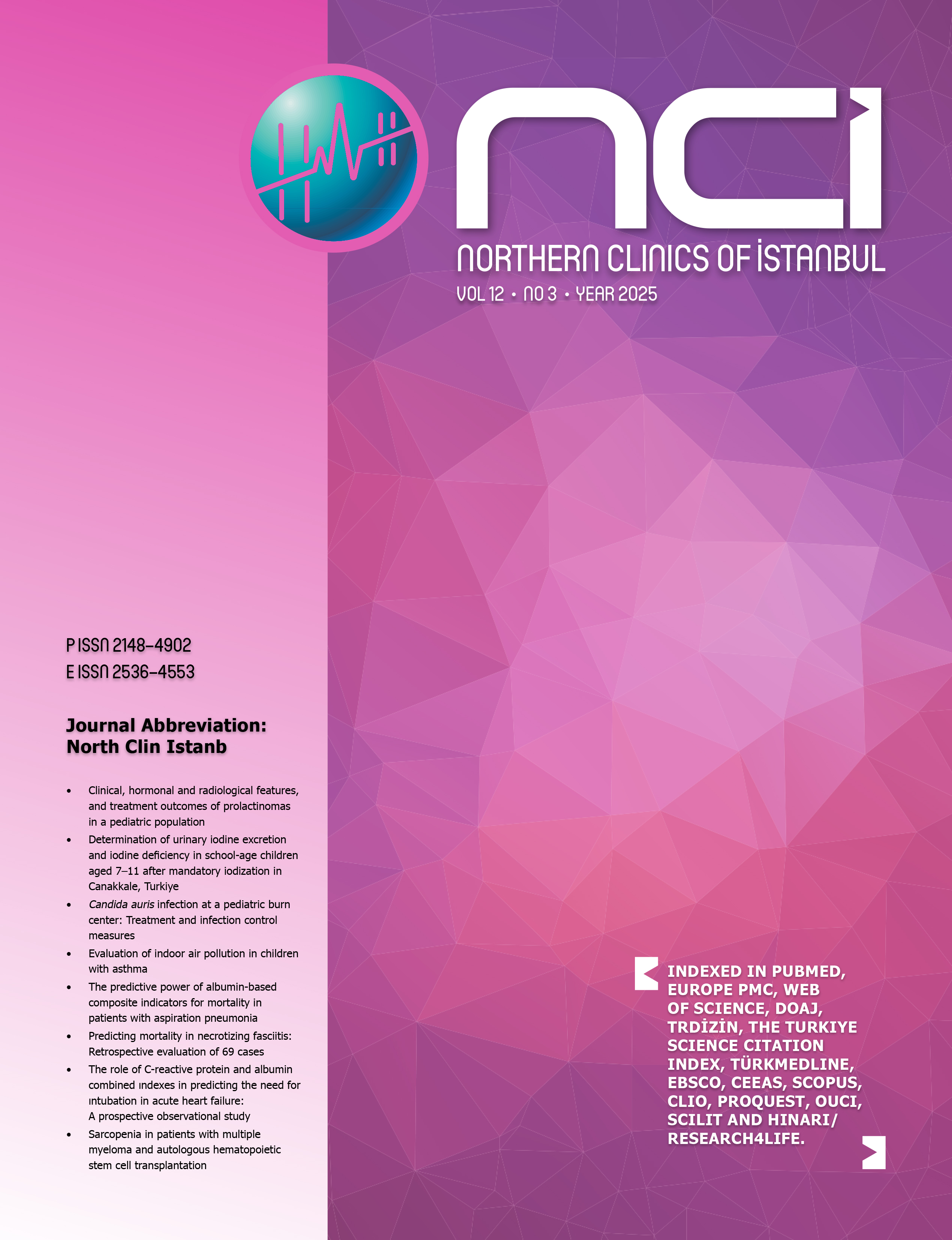Does the severity of diabetic ketoacidosis in children with type 1 diabetes change during the COVID-19 pandemic? A single-center experience from a pediatric intensive care unit
Fatih Varol1, Leyla Gizem Bolac Ozyilmaz2, Ebru Guney Sahin1, Yasar Yusuf Can1, Ugur Altas2, Halit Cam11Department of Pediatric Intensive Care, Health Science University, Sehit Prof. Dr. Ilhan Varank Sancaktepe Training and Research Hospital, Istanbul, Turkiye2Department of Pediatrics, Health Science University, Sehit Prof. Dr. Ilhan Varank Sancaktepe Training and Research Hospital, Istanbul, Turkiye
OBJECTIVE: During the COVID-19 pandemic, health-care services for diseases other than COVID-19 were interrupted, and patient referrals to health institutions were postponed due to their fear of being infected with COVID-19. Under this situation, we conducted this study to evaluate the clinical and laboratory findings of COVID-19 in patients with Type 1 Diabetes Mellitus (T1DM) hospitalized in our pediatric intensive care unit (PICU) with the diagnosis of diabetic ketoacidosis (DKA) during the pandemic period, and the impact of the pandemic on these findings.
METHODS: We retrospectively evaluated 55 children aged from 1 month to 18 years old, diagnosed with DKA, and followed up at Istanbul Sehit Prof. Dr. Ilhan Varank Sancaktepe Training and Research Hospital PICU between April 2020 and December 2021.
RESULTS: A total of 55 patients with DKA as a complication of T1DM were admitted to the PICU during the COVID-19 pandemic. While there was no significant difference in pH and HCO3 values between those with newly diagnosed T1DM and those with previously-diagnosed T1DM, the HbA1c ratio of newly diagnosed DMs was significantly higher. Of the 55 patients, 4 were COVID-19 PCR positive, and two patients had COVID-19 antibody positivity. When COVID-19 positive patients were compared with negative patients, no significant difference was found between the hospital stay, glucose, HbA1c, lactate, pH, and HCO3 values.
CONCLUSION: Higher HbA1c levels of newly diagnosed patients presenting with DKA may be associated with delayed admission to the health institutions due to COVID-19 and the length of insulin-free periods compared to pre-diagnosed patients with T1DM. In conclusion, our results, emphasize the importance of physicians and familys awareness of the symptoms of diabetes in terms of early diagnosis and prevention of DKA during public health measures due to COVID-19.
Tip 1 diyabetli çocuklarda diyabetik ketoasidoz şiddeti COVID-19 pandemisi sırasında değişiyor mu? Pediatrik Yoğun Bakım Ünitesinden tek merkez deneyimi
Fatih Varol1, Leyla Gizem Bolac Ozyilmaz2, Ebru Guney Sahin1, Yasar Yusuf Can1, Ugur Altas2, Halit Cam11Sağlık Bilimleri Üniversitesi, Sancaktepe Şehit Prof. Dr. İlhan Varank Eğitim ve Araştırma Hastanesi, Çocuk Yoğun Bakım Anabilim Dalı, İstanbul2Sağlık Bilimleri Üniversitesi, Sancaktepe Şehit Prof. Dr. İlhan Varank Eğitim ve Araştırma Hastanesi, Çocuk Sağlığı ve Hastalıkları Anabilim Dalı, İstanbul
Amaç
COVID-19 pandemisi süresince COVID-19 dışındaki hastalıklara yönelik sağlık hizmetleri kesintiye uğradı ve COVID-19'a yakalanma korkusu nedeniyle hastaların sağlık kuruluşlarına sevkleri ertelendi. Bu kapsamda, yazımızda pandemi döneminde diyabetik ketoasidoz (DKA) tanısı ile çocuk yoğun bakım ünitemizde (ÇYBÜ) yatan T1DM'li hastaların klinik ve laboratuvar bulgularını değerlendirmek ve bu pandeminin bu bulgular üzerindeki etkisini dğerlendirmeyi amaçladık.
Yöntemler
Nisan 2020 - Aralık 2021 tarihleri arasında XXX Eğitim ve Araştırma Hastanesi ÇYBÜ'nde izlenen, yaşları 1 ay ile 18 arasında değişen DKA tanısı almış 55 çocuğu retrospektif olarak değerlendirdik.
Sonuçlar
COVID-19 pandemisi sırasında ÇYBB'ye T1DM komplikasyonu olarak DKA'lı toplam 55 hasta kabul edildi. Yeni tanı konmuş T1DM'li ve bilinen T1DM'li olgular arasında pH ve HCO3 değerlerinde anlamlı fark bulunmazken, yeni tanı almış DM'lerin HbA1c oranı anlamlı olarak daha yüksekti. 55 hastanın 4'ü COVID-19 PCR pozitifti ve 2 hastada COVID-19 antikor pozitifliği vardı. COVID-19 PCR pozitif hastalar ile negatif hastalar karşılaştırıldığında hastanede kalış süresi, glukoz, HbA1c, laktat, pH ve HCO3 değerleri arasında anlamlı bir fark bulunmadı.
Çözüm
DKA ile başvuran yeni tanılı hastaların HbA1c düzeylerinin önceden T1DM tanısı almış hastalara kıyasla yüksek olması, COVID-19 nedeniyle sağlık kuruluşlarına geç başvuru ve insülinsiz dönemlerin uzunluğu ile ilişkili olabilir. Sonuç olarak, sonuçlarımız, COVID-19'a bağlı halk sağlığı önlemleri sırasında DKA'nın erken teşhisi ve önlenmesi açısından hekim ve ailenin diyabet semptomları hakkında farkındalığının önemini vurgulamaktadır. (NCI-2022-7-18/R1)
Manuscript Language: English





















